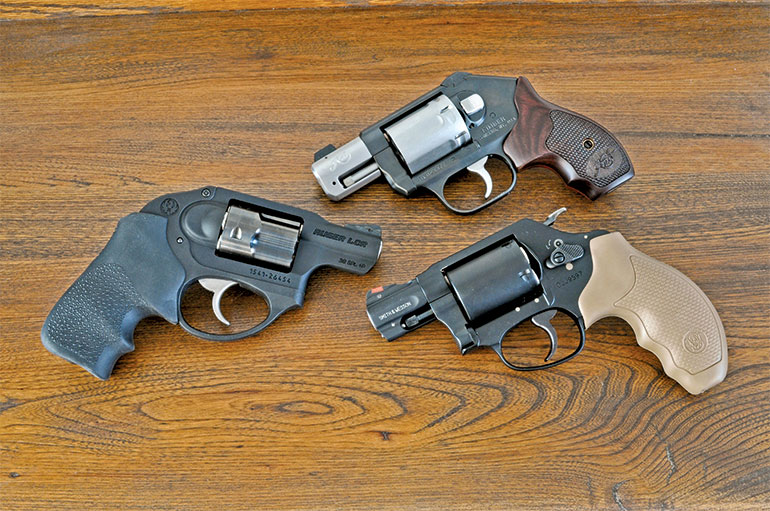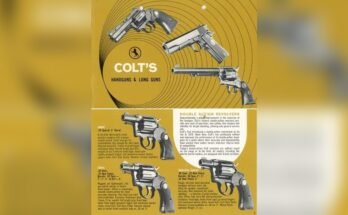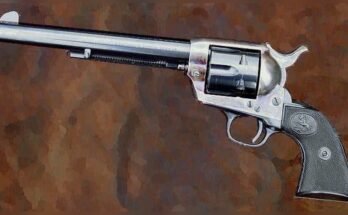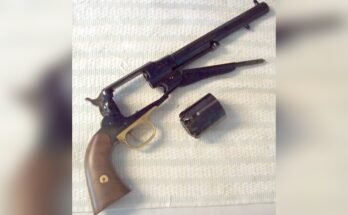Are you curious about snub-nose revolvers but wonder if they’re hard to shoot? You’re not alone.
These compact firearms have a reputation for being tricky to handle, especially if you’re new to shooting. But is that really true? You’ll discover what makes snub-nose revolvers unique, the challenges you might face, and simple tips to improve your accuracy and confidence.
Keep reading to find out if these small guns are a perfect fit for your shooting style.
Snub-nose Revolver Basics
Snub-nose revolvers have a unique place in the world of firearms. Their compact size and simple design make them popular for personal defense. Understanding the basics helps to see why some find them easy or hard to shoot.
These revolvers are known for their short barrels and ease of carry. Their design affects how they handle and perform. Let’s explore the key features, common calibers, and typical uses of snub-nose revolvers.
Design Features
Snub-nose revolvers have barrels usually less than 3 inches long. This short barrel makes the gun small and easy to hold. The frame is often lighter than other revolvers. This can cause more recoil when firing. The grip is designed for quick draw and control. Simplicity is key, with fewer moving parts than semi-automatic guns.
Common Calibers
Most snub-nose revolvers use calibers like .38 Special and .357 Magnum. These rounds balance power and manageable recoil. Some models also chamber .22 LR for less noise and recoil. The .38 Special is popular for self-defense and practice. The .357 Magnum offers more stopping power but can be harder to control.
Typical Uses
Snub-nose revolvers are often used for personal protection. Their small size fits well for concealed carry. Many law enforcement officers use them as backup guns. They also serve well for home defense due to reliability. Some shooters enjoy them for short-range target practice or plinking.

Challenges With Snub-nose Revolvers
Snub-nose revolvers have a unique design that offers easy carry and quick use. Yet, their small size brings some challenges. These issues can affect shooting comfort and accuracy. Understanding these challenges helps improve handling and shooting skills.
Recoil Management
Snub-nose revolvers have shorter barrels and lighter weight. This leads to stronger recoil felt by the shooter. The sharp kick can cause discomfort and reduce control. Managing recoil takes practice and proper technique. Without control, shots may become less accurate and slower.
Accuracy Issues
Short barrels limit the sight radius. This makes aiming harder than with longer guns. Small sights can be tough to align precisely. Rapid shooting adds to the difficulty. The result is less accuracy, especially at longer distances. Training can help improve aim with snub-nose revolvers.
Grip And Control
The compact grip fits smaller hands but offers less surface area. This reduces the ability to hold the gun firmly. Slipping or shifting grips may happen under recoil. Good grip control is crucial for fast, accurate shots. Using grip enhancers or custom grips can help maintain control.
Expert Shooting Tips
Shooting a snub-nose revolver well needs skill and practice. These guns have a short barrel, which can make aiming tricky. Learning expert tips helps improve accuracy and control. Small changes in stance, grip, and trigger pull make a big difference. Focus on basics. Build steady habits. Confidence grows with each shot fired.
Proper Stance And Grip
Stand with feet shoulder-width apart for balance. Keep knees slightly bent. Lean forward a little to control recoil. Hold the revolver firmly but not too tight. Use both hands if possible for better stability. Position your hands so the gun points straight. Avoid twisting your wrist. A good grip reduces movement and improves accuracy.
Trigger Control Techniques
Press the trigger slowly and steadily. Avoid jerking or slapping it. Use the pad of your index finger, not the joint. Practice squeezing the trigger until the gun fires smoothly. This prevents the gun from moving off target. Controlled trigger pulls lead to better shot placement. Take your time. Each shot should feel deliberate.
Sight Alignment Strategies
Align the front and rear sights carefully. The top of the front sight should match the rear sight level. Keep the front sight centered in the rear notch. Focus on the front sight, not the target. Proper sight alignment helps you aim more precisely. Practice looking at the front sight until it feels natural. Clear sight picture brings better results.

Training And Practice
Training and practice are key to shooting snub-nose revolvers well. These guns have a short barrel, which can make aiming tricky. Regular training builds confidence and skill. It helps shooters control recoil and improve accuracy. Below are some simple ways to practice effectively.
Dry Fire Drills
Dry fire drills mean practicing without live bullets. You can do these at home safely. Hold the revolver firmly and aim at a target. Pull the trigger and focus on your grip and sight alignment. These drills improve trigger control and reduce flinching. They also help you get used to the gun’s weight and feel.
Live Fire Exercises
Live fire exercises use actual bullets at the range. Start with slow, careful shots to build accuracy. Pay attention to your stance and breathing. Shooting small groups helps track progress. These exercises train your muscles to handle recoil better. They also teach you how the gun reacts when fired.
Consistent Practice Routines
Consistency is crucial in training with snub-nose revolvers. Set aside time each week for both dry and live fire practice. Keep your sessions short but focused. Regular practice helps develop muscle memory. It makes shooting feel natural and less stressful. Over time, you will notice better control and faster target acquisition.
Choosing The Right Ammunition
Choosing the right ammunition is key to handling snub-nose revolvers well. These guns have short barrels, which affects bullet speed and recoil. Picking ammo that fits your gun and skill level helps with accuracy and comfort. Let’s explore what matters when selecting ammo for these handguns.
Recoil Considerations
Recoil is the backward force felt after firing. Snub-nose revolvers often have strong recoil because of their small size. Using lighter ammunition lowers recoil and makes shooting easier. Heavy loads increase recoil and can cause flinching. Choose ammo that balances power and comfort for better control.
Performance Factors
Ammo performance depends on bullet speed, weight, and design. Short barrels reduce bullet speed, so some bullets may lose energy quickly. Hollow point bullets expand on impact but may slow down more in short barrels. Full metal jacket bullets shoot faster but may not stop threats effectively. Match bullet type to your shooting needs.
Ammo Types For Snub-nose
Common ammo types include .38 Special and .357 Magnum. .38 Special has less recoil and is easier to shoot. .357 Magnum offers more power but is harder to control. Some shooters use lighter .357 Magnum loads to reduce recoil. Practice with different rounds to find the best fit for your revolver and skill.

Maintenance Tips For Reliability
Keeping a snub-nose revolver reliable means regular maintenance. Small guns need care to work well every time. Skipping upkeep can cause jams or misfires. Follow simple steps to keep your revolver in top shape.
Cleaning Essentials
Clean your revolver after every use. Use a soft brush to remove powder and dirt. Wipe the barrel and chambers with a cloth. Avoid harsh chemicals that can damage metal parts. Proper cleaning stops rust and keeps parts moving smoothly.
Lubrication Points
Apply oil to moving parts only. Focus on the cylinder, trigger, and hammer. Too much oil can attract dust and grime. A light coat prevents wear and rust. Use lubricants made for firearms for best results.
Routine Inspections
Check your revolver often for wear and damage. Look at the cylinder lock, trigger, and sights. Tighten screws if they become loose. Replace parts that show heavy wear or cracks. Regular checks catch problems before they grow.
Frequently Asked Questions
Are Snub-nose Revolvers Harder To Control?
Snub-nose revolvers have more recoil due to their short barrels. This makes them slightly harder to control, especially for beginners. Proper grip and stance can improve control and accuracy significantly.
Do Snub-nose Revolvers Affect Shooting Accuracy?
Yes, shorter barrels reduce sight radius, making precise aiming tougher. However, with practice, shooters can achieve good accuracy at close ranges.
Is Recoil More Intense In Snub-nose Revolvers?
Recoil feels sharper because of the lightweight frame and short barrel. Experienced shooters manage recoil well, but beginners may find it challenging initially.
Are Snub-nose Revolvers Suitable For Beginners?
They can be challenging due to recoil and aiming difficulty. Beginners should practice regularly and consider proper training to handle these firearms safely.
Conclusion
Snub-nose revolvers can be tricky at first. Their short barrel makes aiming harder. Recoil feels stronger than with longer guns. But with steady practice, shooting gets easier. Many find them handy for close-range use. They offer quick draw and simple operation.
Comfort and control improve over time. So, don’t be discouraged by early challenges. Keep practicing and focus on basics. Soon, shooting snub-nose revolvers feels natural and safe.



